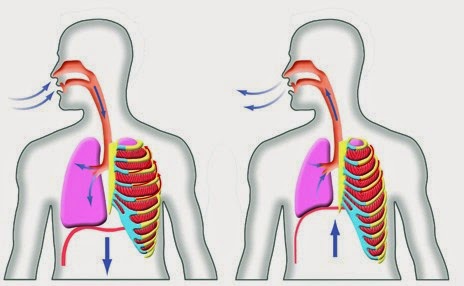* inspired air: air we breath in
* expired air: air we breath out
Testing for CO2
To investigate the differences in composition between inspired and expired air, we use limewater because it change colour when the gas is bubbled through, from colourless to milky.
There is more CO2 present in expired air ---> it makes limewater change colour more quickly (than inspired air).
 |
| Limewater test. |
Effects of physical activity on breathing
* tidal volume: amount of air during normal, relaxed breathing
vital capacity; maximum amount of air breathed in or out in one breath
During normal breathing:
- depth (tidal volume) : ≈ 0.5ℓ
- rate: 12 breaths/ minute
During exercise:
- depth: ≈ 5ℓ (depending on age, sex, size & fitness of person)
- rate: over 20 breaths/ minute
The total lung volume is greater than vital capacity (some air always remains in the lungs). If not, alveoli walls would stick together, the lung would collapse.
Link between physical
activity and rate and depth of breathing
- when you run, muscles in your legs use up a lot of energy.
- cells in the muscles need a lot of O2 very quickly.
- they combine O2 + glucose as fast as they can, to release energy for muscle construction ---> a lot of O2 is needed
- you breath deeper and faster to get more O2 into your blood.
- your heart beast faster to get O2 to the leg muscles as quickly as possible.
- a limit is reached - the heart and the lung can not supply O2 to the muscles any faster.
- some extra energy (not much) is produced by anaerobic respiration: some glucose is broken down without combing with O2:

Glucose --->
lactic acid + energy.
- CO2 and lactic acid concentration in tissue and in the blood ↑ ---> blood pH ↓
- Brain sens the change ---> nerve impulses sent to the diaphragm and the intercostal muscles, stimulating them to contract harder and more often ---> faster and deeper breathing.
Try this
a) The composition of the air inside the lungs
changes during breathing.
i) State three
differences between inspired and expired air. [3 marks]
ii) Gaseous exchange in the alveoli causes some of
the changes to the inspired air. Describe three
features of the alveoli which assist gaseous exchange. [3 marks]
b) i) State what is meant by anaerobic respiration
[2 marks]
ii)Where does anaerobic respiration occur in human?
[1mark]
Answer
a) i) Inspired air contains more O2, less CO2, and
less water vapor then expired air.
ii) Three features
from:
- the wall of the alveolus is one cell thick (or
very thin)
- there is a moist surface to the alveoli
- there are large number of alveoli
- the air in the alveoli is constantly being
replaced.
b) i) The release of energy by cells without the
use of oxygen.
ii) In muscle cells.


thx! you helped me to get qan A* in my IGCSE exams !!!
ReplyDelete